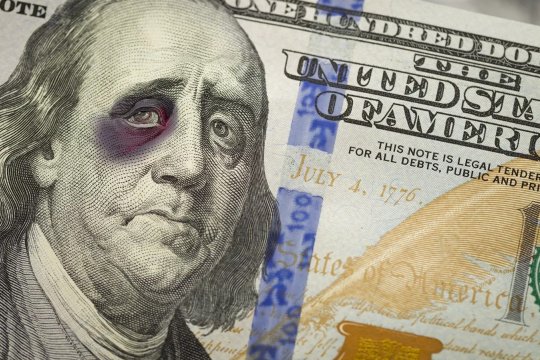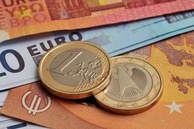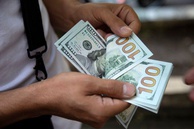The ongoing escalation of trade wars and competition among the world’s top economies makes it imperative to consider institutionalizing several currency zones to form a sort of currency “multipolarity”.
The forthcoming “currency multipolarity” became the subject of disputes in the 1990s, after the launch of a project to create a EU currency. Robert Mundell, the author of Optimum Currency Areas and winner of the Swedish National Bank’s Nobel Memorial Prize in Economic Sciences, predicted in 2000 that by 2010 the euro would cover at least 50 countries. The dollar would de facto become a common currency for Latin American countries, while Asia would move towards a currency area under the aegis of the Japanese yen. Being within such zones, under the cover of strategic alliances, countries can carry out a coordinated currency policy and put up a joint resistance to market fluctuations.
However, the history of a battle between the euro and the dollar has turned out to be controversial. On the one hand, by 2019 the euro had made a tangible contribution to the weakening of the positions of the US dollar in global economy. According to the European Commission, at that time one fifth of global currency reserves were linked to the single European currency. «340 million people use it on a daily basis, 60 countries and territories link their currencies to it»[i].
On the other hand, sanctions and tariff strikes by the Trump administration against nominal allies over the past two years have demonstrated that Europe is still highly dependent on the financial system which hinges on the US dollar. In general, despite its successes of the past 20 years, the euro has yet to go beyond the “clearly set” boundaries of a regional currency.
Unexpectedly for many financial experts, the early 2010s saw the speedy arrival on the global financial and economic scene of China. According to The Economist, the results of 2019 say that yuan-denominated debt instruments outnumbered the pound, the euro and the Japanese yen. But not the dollar. The share of the dollar revolves around 52-55 percent throughout the years that have passed since the 2008 financial crisis.
In the course of the coronavirus crisis the Chinese bond market demonstrated the best resilience. By the end of the first six months capitalization of the market exceeded 14 trillion dollars, the world’s second position (capitalization of the US bond market is around 42 trillion dollars). The yields of the Chinese government’s bonds exceeded the American ones more than fourfold. [ii].
In recent years China has considerably strengthened its position of a world creditor, by far overtaking the USA. By early 2020, direct and trade loans, issued by Chinese state-run and privately owned businesses to more than 150 countries, exceeded 1.5 trillion US dollars. China has officially assumed the position of the world’s number one creditor, leaving behind the World Bank, the IMF, and the governments of OECD taken together[iii].
A third factor that, according to the economic theory, must contribute to the promotion of national currency as a global one, is leadership in financial technologies. The Chinese financial technology is already one of the most advanced worldwide. At its disposal is the billion-worth market at home and nearly 2.5 billion people in “third world” countries which have no access to the traditional financial services of western companies and banks.
Finally, a fourth factor facilitating the rise of national currency is the coronavirus pandemic, which provided a powerful impetus for millions of employees to switch to online work. Next to come were the financial services and Internet trade, in which China holds equally top positions. Beijing’s progress in dealing with the pandemic, along with an ever greater number of countries expressing distrust of the US policies, fuels interest in the yuan. Meanwhile, the transition of the USA and China to a “cold” financial, technological and economic war appears inevitable. All these factors combined create the prerequisites for currency division. According to Nihon Keizai Shimbun, “in a divided world it is extremely unadvisable for one currency to become a model one”.
Discontent over the current position of the dollar is felt inside the United States as well. In May Foreign Affairs complained that the dollar, which has become very costly due to the influx of “superfluous” capital, is inflicting damage on the production sector, “eliminates” jobs in unstable states, aggravates political polarization inside the country. If the influx of capital into the USA continues to increase, "……it will be more and more difficult to ensure a balanced and even growth”. “ At some point the USA will have no choice but introduce restrictions on the import of capital in the interests of national economy – even if it means a voluntary rejection of the global supremacy of the dollar as a reserve currency”.
On August 27 the US Federal Reserve Service issued a statement on changes in its monetary and credit policy, which observers deem as “destruction” of the existing system. The new policy of the American Central Bank can be viewed as a signal of readiness for reconsidering the international role of the dollar in the direction of downgrading its stance.
Some experts believe, however, that an abrupt departure of the dollar from the position of a top global currency, including a “sudden” arrival of a fairly strong alternative reserve currency, can provoke a «large-scale economic crisis in China», «a fall of oil prices by several times», and a rapid reduction of “economic activity across the globe”[iv]
In addition, any currency that claims a reserve status, even if at a regional level, will have to overcome several obstacles. The first one deals with the logic of economic entities. According to The Economist, one hypothesis maintains that denomination of prices in one currency, particularly on highly competitive markets, makes it possible for companies to avoid sharp fluctuations of prices compared to their competitors. The other assumption argues that using the same currency for both imports and exports protects against losses in case of denomination of national currency.
It is highly probable that it is these factors that explain correlation between the share of dollar and euro “blocs” [v] in the global gross product (approximately 60 and 25%) with their share in currency reserves (in September 2014 — 60,7 and 24,2%). Also, they account for “a relative stability of the volume of dollar currency reserves despite ……a reduction in the share of the USA in global economy in the past decades” [vi]. This logic can also explain the low percentage of yuan transactions in global trade. In different estimates, the share of payments in yuan in trade transactions made up 1.5-2 percent in early 2020[vii]. For comparison, China’s share in global commodity trade is 10 percent[viii].
The second obstacle has to do with the “historical” linkage of many commodity prices, in the first place, oil prices, to the dollar. At present, the global oil market is a single and spot one[ix]. Transactions on this market are short-lived and are clinched in dollars, to minimize risks and cut costs. There is a viewpoint under which the main purpose of the American “slate revolution” is to preserve such a state of things on the oil market. Also, to bring the world gas market to the “spot” format. Such a reformatting of markets will make it possible to preserve the linkage of oil and gas market to the US dollar.[x].
Finally, the third obstacle, the most fundamental one, is of geopolitical nature. It tests the ability of the emitter of global reserve currency to create and maintain a stable world order, in the center of which it resides. The temporary lag, from the 1880s, when the United States surpassed the British Empire in production, to 1944, when the agreements in Bretton-Woods were signed, demonstrates the importance of geopolitics in the process of replacing the British pound with the American dollar as a leading world currency.
On the whole, so far playing against the yuan are the high costs of “carrying out financial transactions, related to obtaining and disseminating information”; the limited capacity of “China to produce political influence on other global economic centers, mainly the United States and the EU”; “China’s dependence on Hong Kong as a regional offshore financial center”[xi]. Beijing cannot afford free movement of capitals in the absence of “fundamental” and “politically challenging” structural reforms in the economy.
Speaking against the euro is the absence, unlike the main competitors, the dollar and the yuan, of a “solid foundation”. The EU common budget is set to pay subsidies to member countries, while years-long disputes about establishing a common ministry of finance all but fuel discord in relations between 19 governments of eurozone countries. The growth of Eurozone “strongly depends” on export “and on the corresponding export of capital”.
The optimistic way out of the current situation is agreement between three top economies, the USA, China and the EU, on forming a currency basket, similarly to the IMF rules of drawing loans. In this situation, the function of regulating “the basket” goes to either the IMF, or “a new international financial institute set to this end”[xii]. In case the events follow an unfavorable scenario, “given the world’s division into blocs currencies could also split into sectors”[xiii].
However, in Eurasia and in the Middle East the idea of “optimum currency area” would be particularly hard to put into practice. The author of the concept, Robert Mundall, insisted that for a successful currency integration “it was necessary to guarantee maximum economic openness; close trade ties with partner countries: correlation of economic cycles which develop in separate countries with a cycle that is inherent in the major economic integration potential”[xiv]. Russia is demonstrating a good example of policy for countries which are not ready to enter either the dollar zone or the euro area.
Moscow has been diversifying its currency reserves in recent years, focusing on the yuan as well. Amid the aggravation of trade wars, gold is becoming an alternative to the existing reserve currencies. Gold will do a good service to countries in case of the arrival of a currency basket, to strike a compromise between the dollar, the euro and the yuan.
The Russian Central Bank has been systematically purchasing gold since 2005. The purchase of gold reserves has been gaining pace since the second half of the 2010s, which is largely “due to the political and economic situation in the world and Russia’s determination to reduce dependence on the unpredictable US policy and the dollar”[xv]. China too, has been buying gold, just as many “developing economies”. The coronavirus crisis has changed radically the formerly skeptical attitude of western politicians and commentators to the policy of purchasing gold. Particularly after the price of gold exceeded an 11-year maximum at the end of July. At the same time, gold does not earn interest but requires spending on storage.
In general, if the formation of currency multipolarity is accompanied by rate fluctuations and chaotic transition of capitals from one currency into another and back, it will surely lead to either a new global crisis, or will dramatically aggravate the current one, should it linger for several years. Meanwhile, China or the EU are hardly interested in an early fall of the dollar: an excessively high yuan or euro rate will undermine the positions of Chinese and European producers and conversely, provide American exporters with unjustified advantages.
Financial markets today are a system of communicating vessels. Also, the years following the 2008 crisis saw the return of interest in “Keynesian methods”, which envisage a substantial control of the economy on the part of the government. The corona crisis has fueled political moods in favor of currency sovereignty. Presumably, changes in the distribution of power among reserve currencies will hardly run ahead of changes on the geopolitical scene.
The opinion of the author may not coincide with the position of the Editorial
[i] https://www.inopressa.ru/article/19Dec2018/lemonde/euro.html
[ii] https://www.cnbc.com/2020/06/19/the-chinese-bond-market-is-a-standout-globally-says-ubs.html
[iii] https://hbr.org/2020/02/how-much-money-does-the-world-owe-china
[v] The author means all countries that use, accordingly, the dollar and the euro as the main currency for foreign trade transactions.
[vii] https://www.euromoney.com/article/b1k9q7184bwx19/chinas-rmb-is-less-popular-as-it-ages
[viii] https://www.regulationasia.com/china-to-promote-cross-border-use-of-renminbi-says-pboc/
[ix] Spot (transaction) — the terms of payments under which the money is paid immediately (as a rule, within two days). “Spot” transactions are also known as “cash” or “pay-box” deals.
[x] http://expert.ru/expert/2017/37/trubyi-goryat/
[xii] https://inosmi.ru/economic/20200729/247836062.htm
[xiii] https://inosmi.ru/politic/20200819/247956420.html
[xiv] https://monographies.ru/en/book/section?id=4233
[xv] https://interaffairs.ru/news/show/23162
read more in our Telegram-channel https://t.me/The_International_Affairs

 9:23 02.09.2020 •
9:23 02.09.2020 •



























